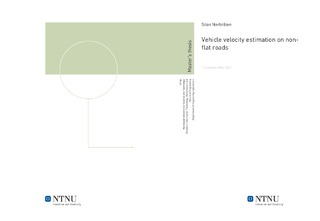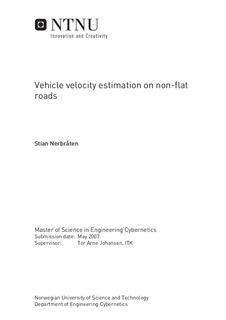| dc.description.abstract | The main purpose of this report, is to evaluate feasibility of using The Global Positioning System as an aiding tool for vehicle state estimation based on nonlinear techniques, and to develop a potential solution to the road bank angle problem. Previous work within the CEmACS project, includes development of a general nonlinear observer for lateral and longitudinal velocity, and an augmentation in the form of road-tire friction adaptation. Because the existing solutions have been shown to lack robustness with regards to certain disturbances, such as road grade and road bank angle, it has been stated that the estimation scheme should be upgraded, so that these disturbances can be accounted for. By including GPS velocity or a or a roll rate gyro measurement in the observer feedback loop, the possibility of detecting previously inobservable quantities is gained. In simple terms, evaluation of feasibility corresponds to demonstrating improvements and limitations of new solutions, using relatively crude methods in the test procedures. Problems related to the above mentioned task, are approached by means of signal processing and control theory. Following an intuitive sequence of operations, the report presents GPS theory and results first, as this lays the foundation for all subsequent results. Methods used comprise simple differentiaton, rotational kinematics and discrete filtering. Secondly, theory and results related to nonlinear observers, with focus on GPS aiding, are examined thoroughly. Lyapunov theory, known from control engineering, is used to evaluate stability, while data from simulations and actual vehicle tests is used to show how a new observer scheme can improve existing solutions. Before the most important results are presented, something should be said about their accuracy and significance. It has already been pointed out that the methods used are not based on optimality requirements, and consequently the results are best viewed as indicators of potential, rather than absolute solutions. This is especially true for the GPS velocity calculations, which are based on differentiation of position measurements; generally not a desired approach. In this report, it is firstly shown that GPS position measurements can be used to compute receiver velocity in the body-fixed coordinate frame. While this is a crude approach, resulting in relatively poor signal to noise ratio, it is easily implemented on low-level equipment. It is also shown that it is possible to use these velocities as measurements in a nonlinear observer structure, slightly modified from previous solutions within the CEmACS project. By doing this, accurate estimates of road grade and bank v angle are achieved, so long as these vary slowly enough. Stability of the observer is not proven in the general sense, but it is shown that it can be made stable through realistic assumptions and gain selection. Stability is further demonstrated through the use of data sets from actual vehicle tests. Secondly, a mathematical model of roll dynamics is combined with a roll rate measurement to create the possibility of detecting road bank angle. This is done by the now familiar nonlinear observer approach. Usefulness is demonstrated by simulations, but no stability proof is presented. The main conclusion is that it is feasible to use GPS aiding to account for robustness problems in a vehicle state estimation scheme, and that the inclusion of a roll rate measurement opens up possibilities for cheap bank angle detection. A direct implementation of results presented in the report may not be ideal, but the fact that the system works for a large set of conditions, suggests that it is worthwhile to develop it further. This is especially true when it is assumed that GPS receivers will become an integral part of new vehicles in the near future. Refinements and upgrades can be made in the form of more advanced GPS technology, new parameter estimation techniques and integration with the road-tire friction adaptation scheme. | nb_NO |

